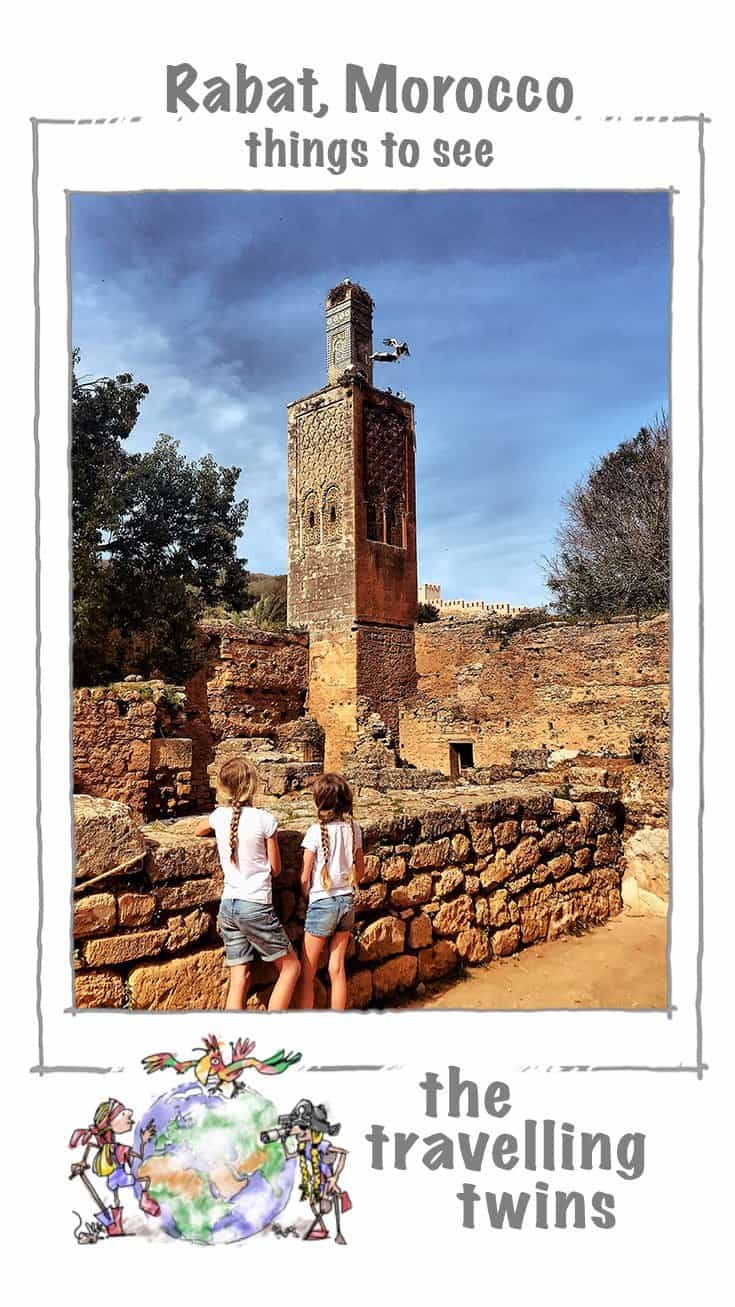Alongside Fez, Marrakesh, and Meknes, Rabat is one of the four royal cities of Morocco and is also its capital. The name means a “Fortified Place” and Rabat lives up to this with its spectacular ramparts. We spent a week there, finding and trying all that this Moroccan city has to offer, and if you are planning to visit the capital of Morocco, read on about Things to do in Rabat.
What to see in Rabat
Go and see the Chellah and Storks.
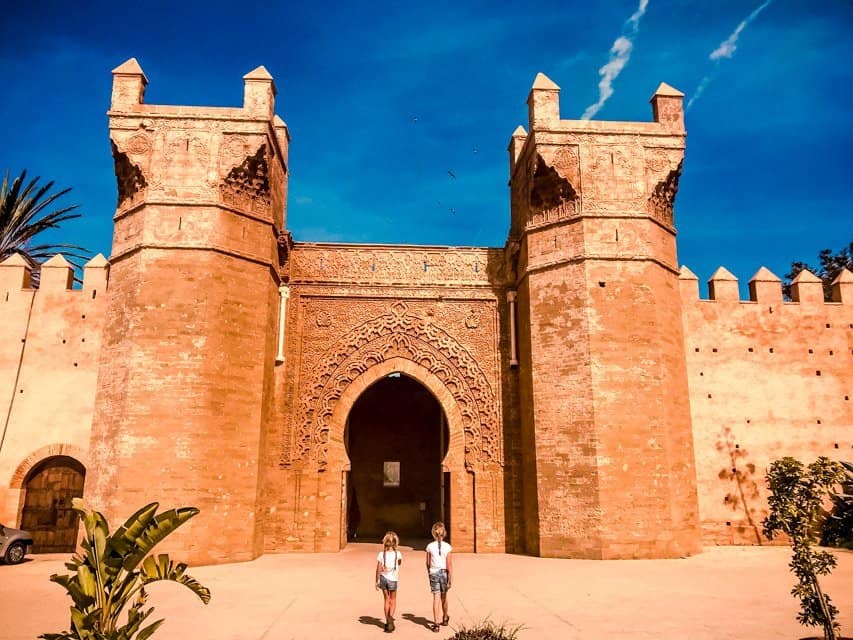
Chellah is the old Roman town and is defended by a 6-metre wall. Chellah was founded as a trading port by Phoenicians before 1000 BC, later controlled by the Carthaginians, and then rebuilt by the Romans in about AD 40. It was subsequently occupied by Berbers and Arabs. The city was abandoned in 1154 and since then, the Roman ruins and the Medieval Muslim cemetery are home to countless ginger cats and white storks.
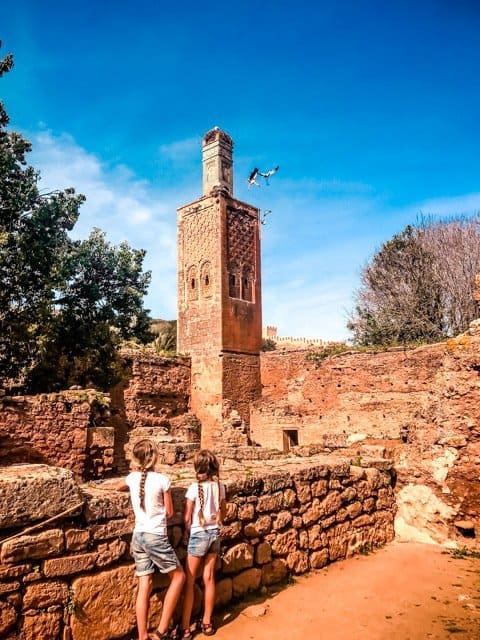
White storks are everywhere. There are over 70 families, nesting on trees, columns and minarets. They make lots of noise – though I believe that may be because it was mating time when we were there.
How to get to Chellah
Chellah is in the metro district, a fifteen minute walk from Rabat Ville station.
- By taxi – it shouldn’t cost more than 15-20 dhs from the Medina.
- On foot – we took a pleasant 40 minute walk to Chellah from the Medina
Plan your Trip – How Long should you spend in Chellah?
It can take anything from one to 3 hours, all depends on how much you want to learn about the place.
Chella – tickets and opening hours
Admission tickets cost 70 Dhs ($7) for adults and half price for kids. It seems a bit steep, but this site is incredible, and we felt well worth the cost.
The Mausoleum of Mohammed V and the Hassan Tower
The Hassan Tower
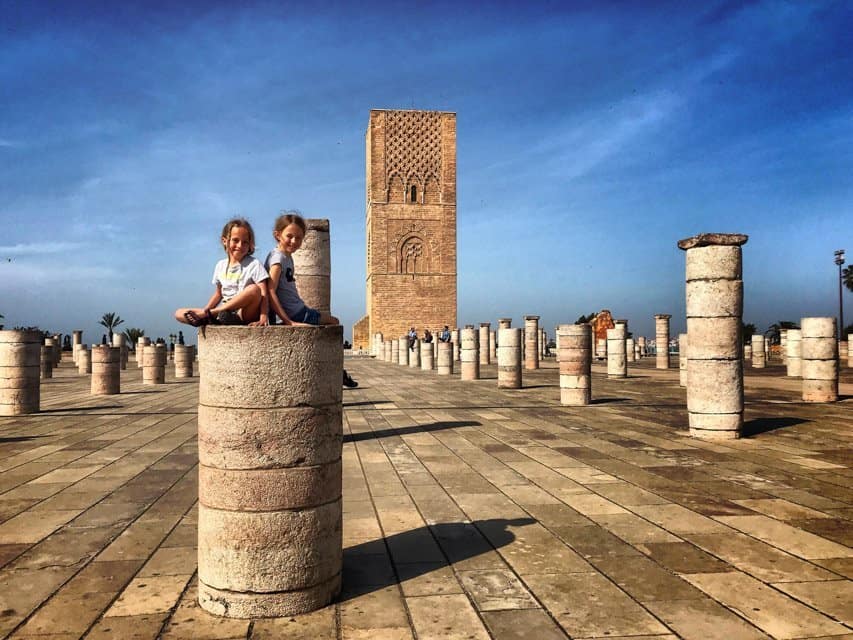
Le Tour Hassan, commissioned by Abu Yusuf Yaqub al-Mansur in 1195, was intended to be the largest minaret in the world at 86 metres, along with the largest mosque. Construction stopped in 1199 when al-Mansur died. By this time the tower was 44m high as you can see it today. It is built of red sandstone, and the site includes other unfinished outside walls and 348 half-finished cylindrical stone columns, tempting naughty children to use them as climbing posts..
Opposite Hassan Tower is the Mausoleum of King Mohamed V
Mausoleum of King Mohamed V
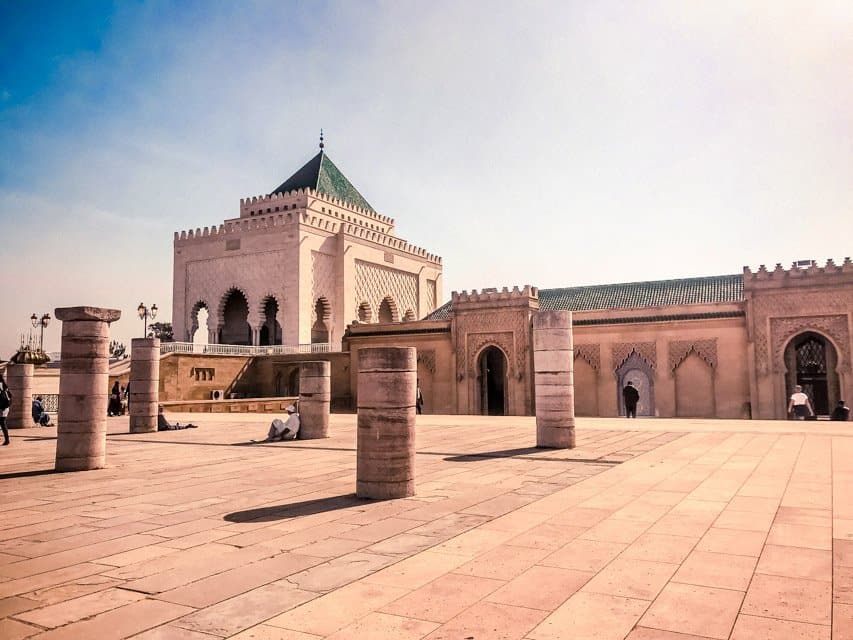
King Mohamed V was the great-grandfather of the present King, Mohamed VI. The Mausoleum of white marble contains the King’s tomb and those of his two sons.
Admission to the whole complex is free, but you have to dress respectfully to pass the Royal Guard at the gates.
The mausoleum is open every day except between noon and 14:00 when it is closed to the public for midday prayers.
Kasbah des Oudaias
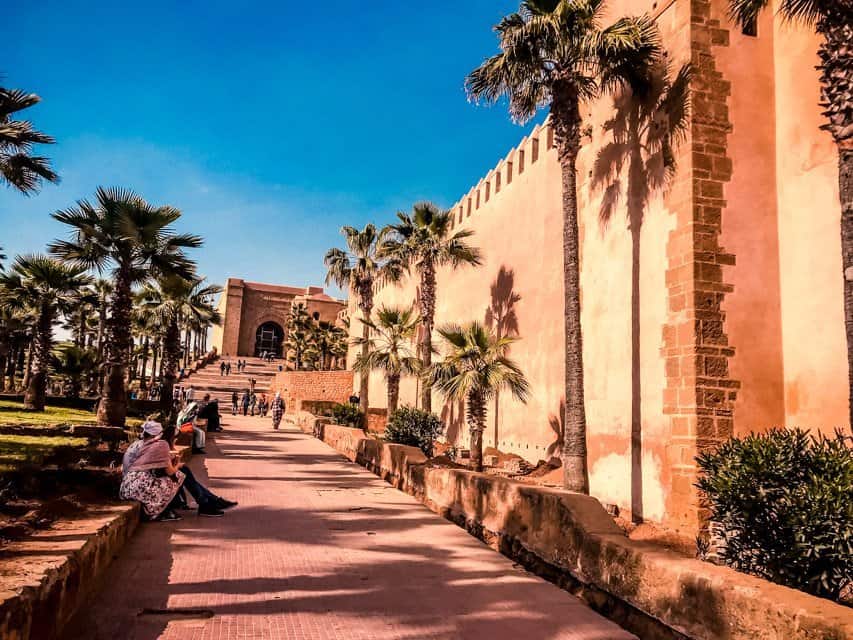
Le Kasbah des Oudais (Kasbah of the Udayas) is near Rabat Medina. The kasbah is a very picturesque residential area with meandering blue streets. From the viewpoint at the top, you can see Rabat beach and Salé located on the other side of the Bou Regreg river.
Entrance to the Kasbah is free, but you may get hassled by “guides” offering to show you around. You don’t need guidance. The Khasba is very small – just allow yourself to get lost.
Just below the Kasbah, and bounded by the same walls you will find the Andalusian Gardens.
Andalusian Gardens
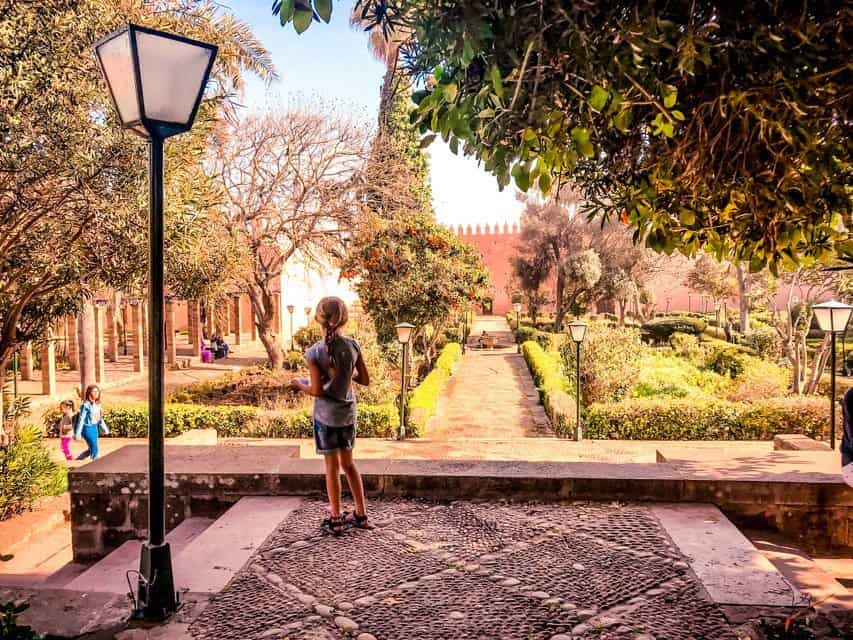
The Andalusian Gardens are a perfect hideaway from the heat and hassle of Rabat streets. In the beautifully landscaped gardens you will find numerous friendly stray cats. The gardens can get crowded with locals who use it for their romantic walks.
Stroll in the Old Medina
Rabat’s Medina was founded in the 12th century by Abd al-Muʾmin. Typical for a Moroccan Medina, it is a maze of streets and souqs with secret private courtyard houses (riads) hiding behind mysterious alley walls.
The main market street is Rue Souika where aloe butter is squeezed in front of you, Cows’ legs, goats’ heads, spices, souvenirs and fake Dior bags all jostle for space. The air is alive with the screams of vendors to customers, the calls of beggars for alms and the mixed smells of meat, Moroccan spices and life. Rabat Medina is a rich hotpot – not as charming as other Moroccan Medinas, but a must to experience.
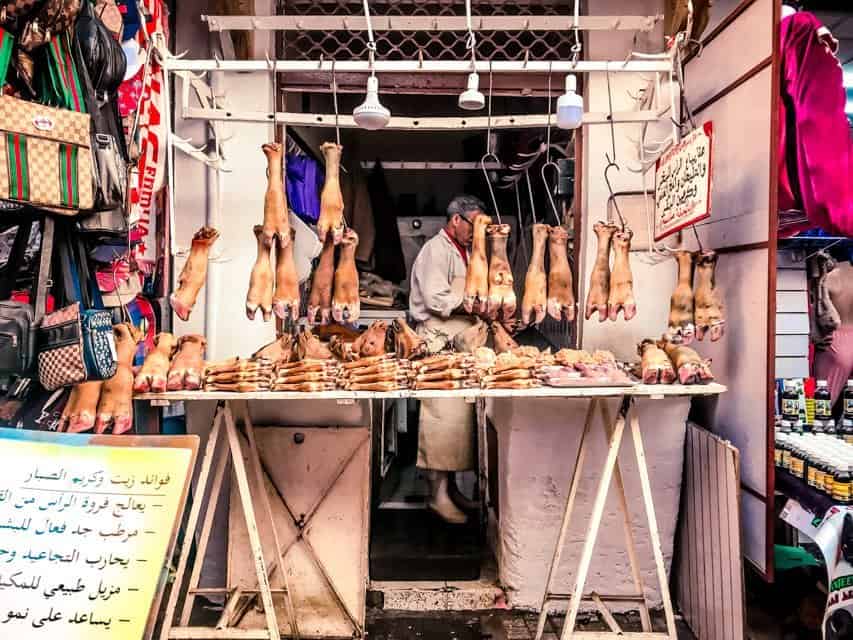
Visit Rabat’s Ville Nouvelle (New Town)
Rabat’s Ville Vouvelle was developed under French Protectorate in the early 20th Century when the French established Rabat as the capital of Morocco. La Ville Nouvelle was designed by Henri Prost – French architect and urban planner. A walk from the train station (Rabat Ville) towards the old town will take you along l’Avenue Mohammed V. With its formal layout of palm trees and lawns it is very much the grand civic entrance to the new French capital.
If you want to stay in a modern comfortable hotel and still be close to the old Medina then Ville Nouvelle is a great choice.
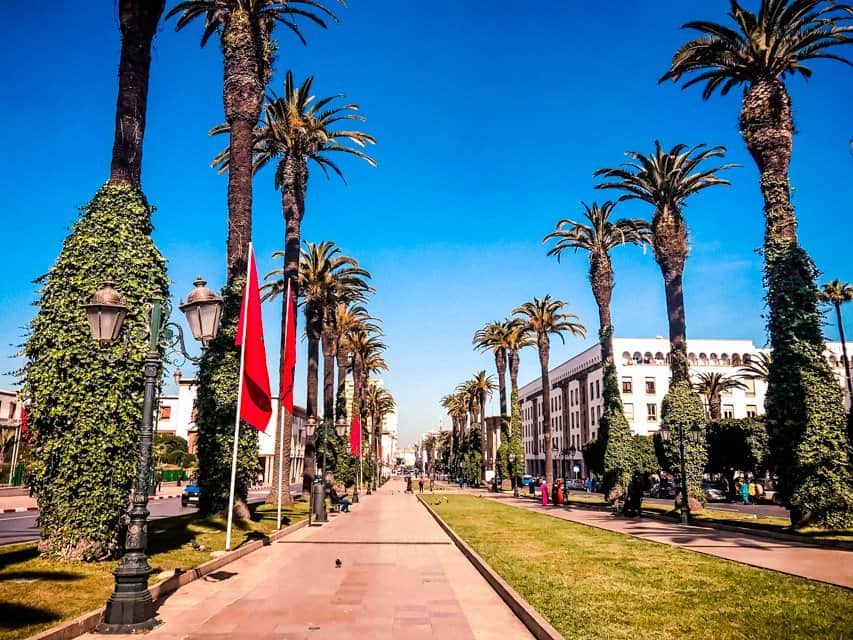
Cemeteries around the Rabat Medina
We discovered the cemeteries around Old Medina by accident, while trying to find a shortcut to the lighthouse. Once we entered we were mesmerized by the number of graves, there are thousands of them. It was a great reminder of how many people have lived here in the chequered history of the city. Those who built this city and those who lived in it and contributed to its form and culture.
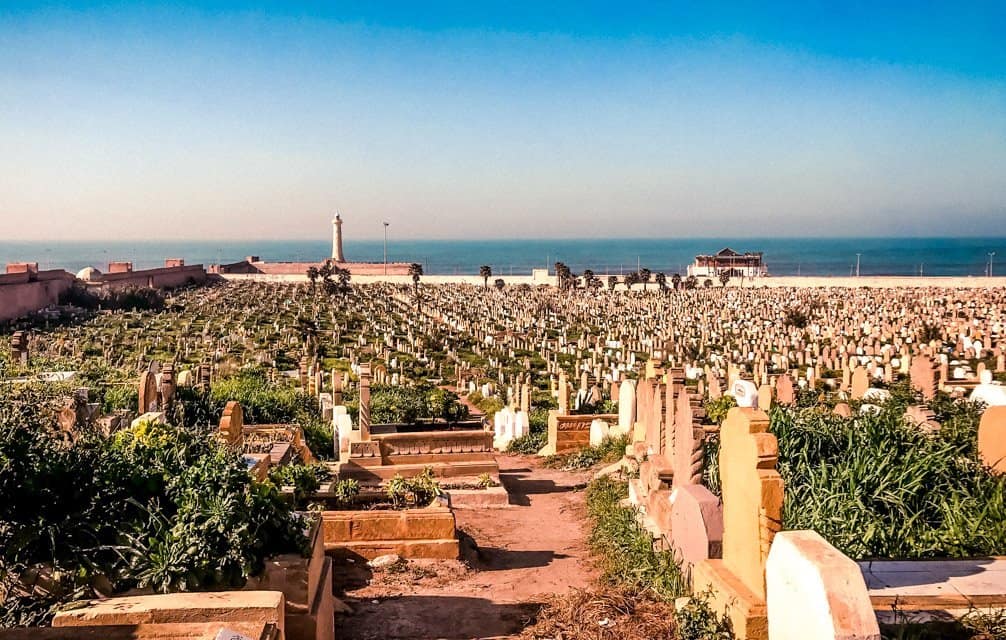
Rabat Archaeology Museum
The Rabat Archaeology Museum is a small but interesting museum showing the pre-Islamic history of Morocco. There is a fascinating display of bronze statues (The Salle des Bronzes ). As with the museum in Essaouira, the descriptions are only in French and Arabic. Google Translate can provide some amusing interpretations sometimes!.
Many of the artefacts come from Chellah and the archaeological excavations at Volubilis near Meknes.
One hour is enough to see the museum. Rabat Archaeology Museum is open every day except Tuesdays from 10:00 am to 18:00.
Tickets cost 20 Dhs
Go to the Beach – Plage de Rabat
This is a great place to go and see the sunset or watch the Moroccan boys playing football. Apart from sandcastles, sunbathing and swimming you can also go surfing.
Lighthouse
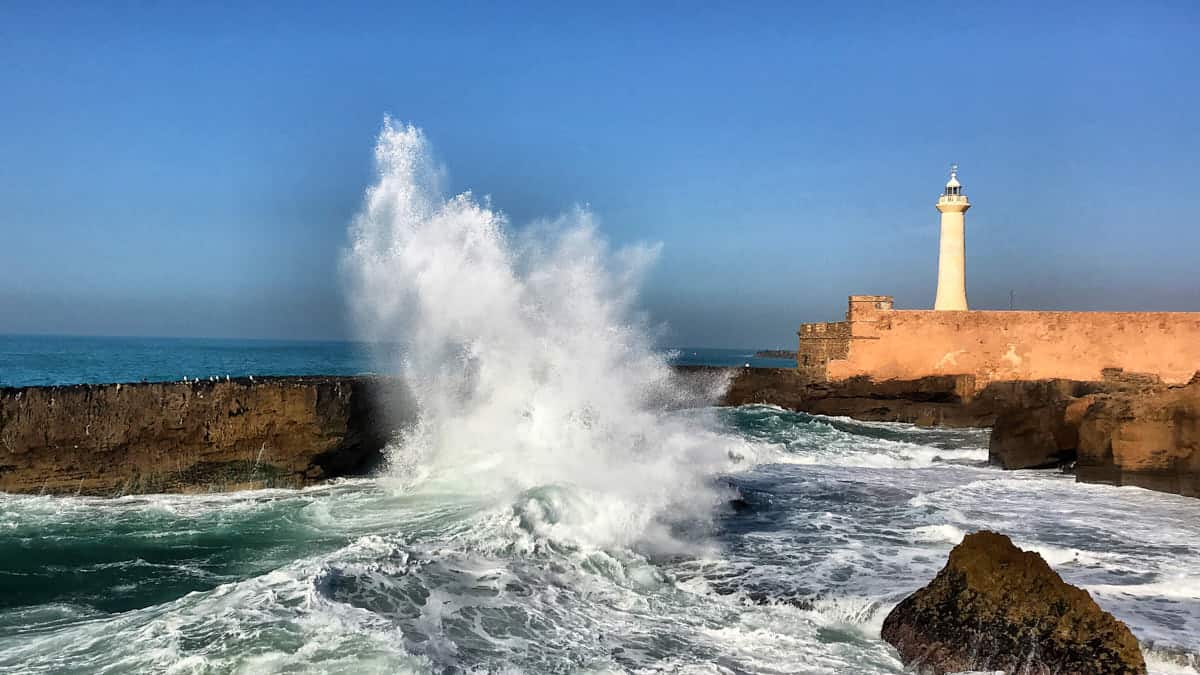
Rabat Lighthouse is currently closed for restoration, though we still managed to peep inside. There is a lovely walk close to the lighthouse where we watched waves breaking over the rocks.
Things to do in Rabat – Visit Salé Medina
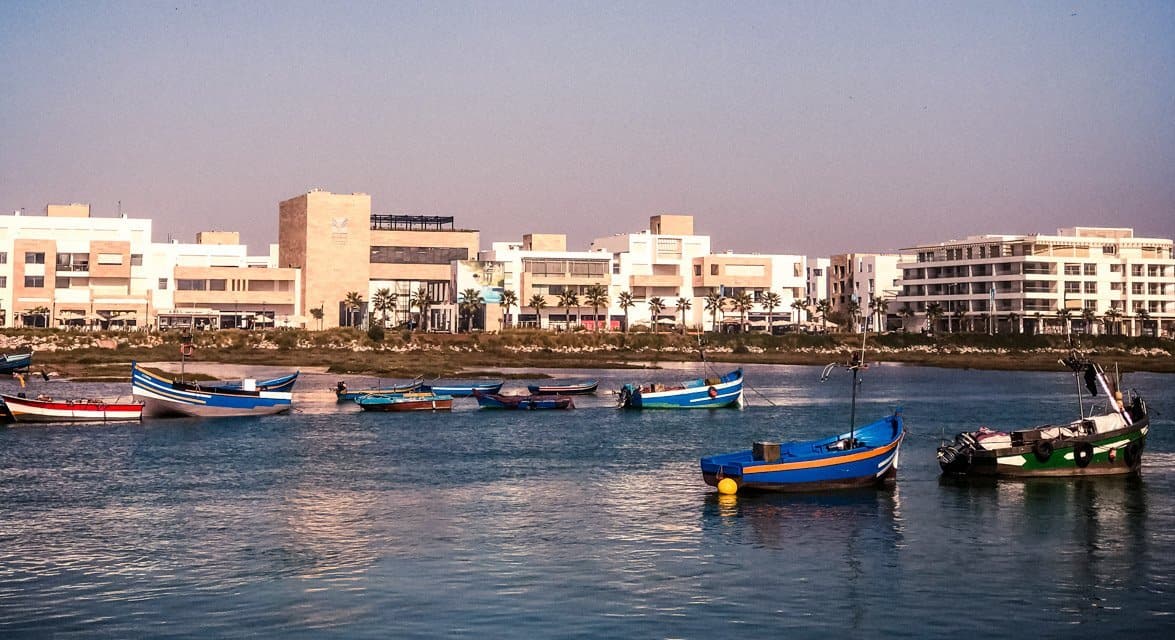
Salé (where the airport is) is located on the other side of the Bou Regreg river. In ancient times Salé and Rabat developed simultaneously on opposite sides of the river
As well as Taxi you can get from Rabat to Sale by tram or by boat.
Visit the National of Morocco in Rabat
The new Rabat Zoo opened seven years ago and is well designed with five different biozones (the Atlas mountains, the desert, the wetlands, the savanna, the tropical forest) each with animals native to that habitat.
The Zoo has a number of attractions including –
- feeding animals in which you can participate.
- a vivarium showing the biodiversity diversity of African reptiles
- a museum showing the history of the animal populations and the paleontological heritage of Morocco
- there are also guided tours takig all these attaractions and with additional vetinaray information.
Opening hours
- From April to September – From 10:00 to 18:30
- From October to March From 10:00 to 16:30
- Ramadan From 10:00 to 15:30
Entrance prices
- Adult – 50 dhs ($5)
Kids (3-12 yr) – 30 dhs ($3) - – entrance to the museum and guided tours cost extra.
Mawazine Music Festival
If you are in Rabat at the end of June the Mawazine Festival is a must.. It’s the annual Moroccan international festival of music. This year – 2019 it will be from 21-29 June 2019.
Getting around Rabat
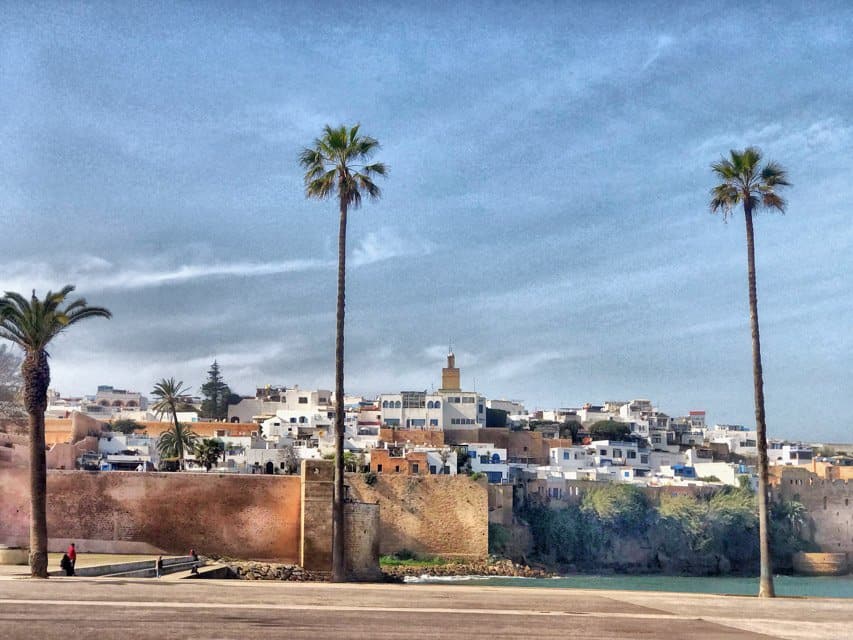
On Foot
We like to walk out of preference and Rabat is compact enough to be able to walk everywhere. To cross the river to and from Sale, we used both the tram and the boat.
Petit Taxi
Taxis are everywhere. Unlike most places in Morocco, the taxis here have a meter (though you may have to “remind” the driver to use it!) , Minimum fare is 5 dhs. And fares within Rabat city limits shouldn’t be more than 30 dhs ($3) Petit taxis are limited to three passengers.
Ride the new tram
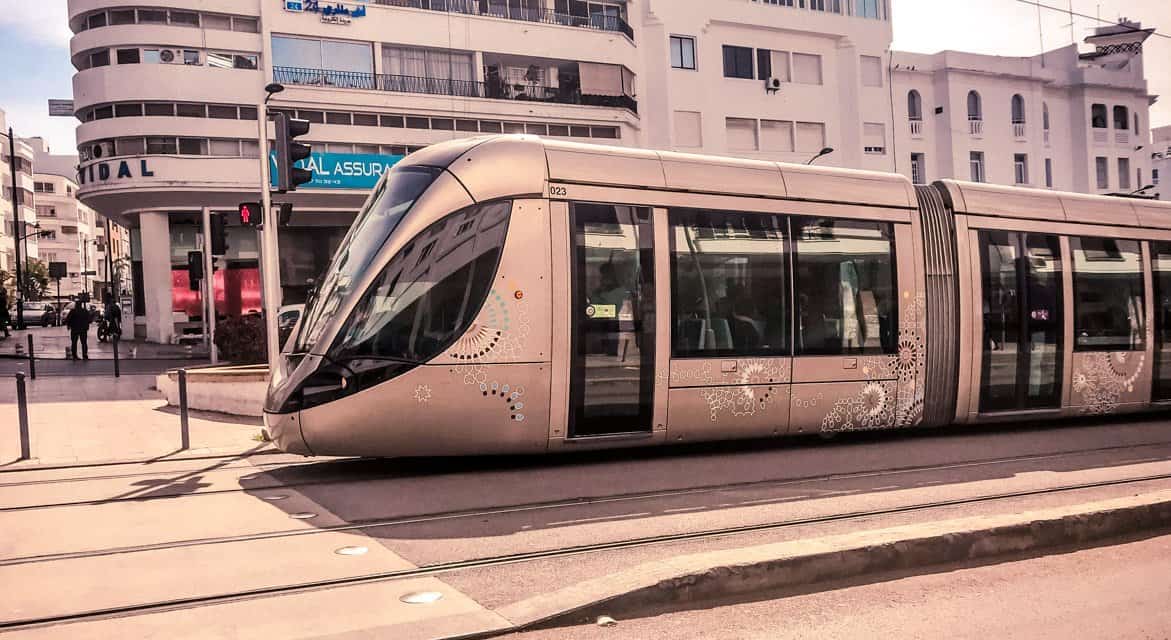
There is a brand new tram. There are two lines both going between Rabat and Sale. Single fares are 6dhs. Trams run from 06:00 to 23:00 daily every 10 minutes (or 20 minutes on Sundays). Buy tickets at small kiosques next to tram stops.
Take the Boat
The boat from Rabat to Sale costs just 2 Dhs (20 cents). To book your seat, just show up on the bank of the Bou Regreg close to the Andalusian Garden
Bus – Don’t take it
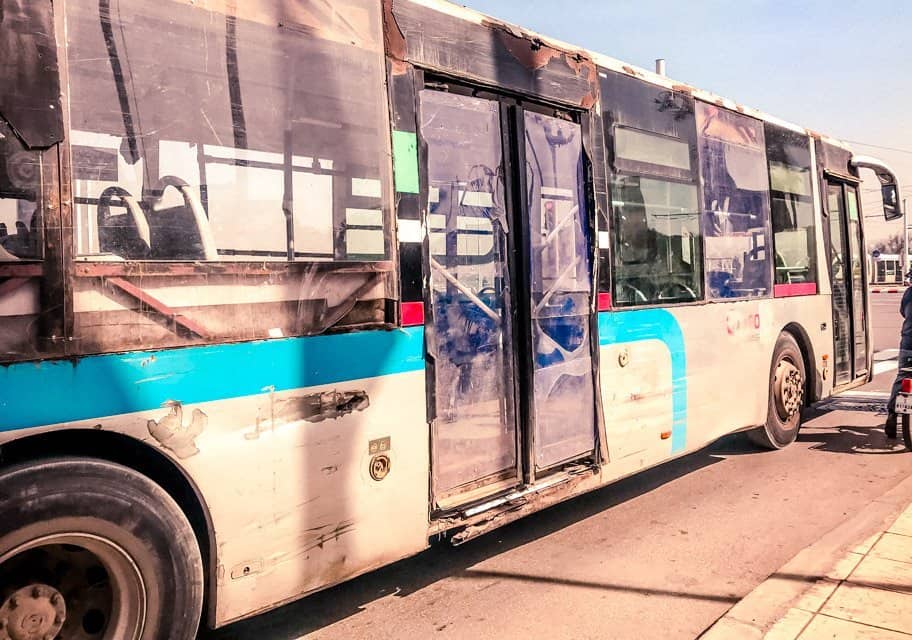
There are buses on the streets of Rabat, but I would never ever get on any of them. Tthis picture shows the state of them in March 2019, Perhaps they will get better by the time you read this. If so let me know.
How to get to Rabat
By Air to Rabat-Salé Airport
Rabat’s international airport – Rabat-Salé is quite small, but as well as serving Royal Air Maroc it hosts flights by Air France and Transavia (Paris) Etihad (Abu Dhabi) as well as Ryanair who fly there from no fewer than ten European cities.
Apart from private transfers arranged by hotels, there are two ways to get into town from Sale: Taxi and Stareo Shuttle Buses.
Taxi – will cost you about 150 – 200 dhs ($15 – 20)
Express Airport shuttle bus – Stareo – bus departures are aligned with arrival times – the buses leave the airport about an hour after scheduled flight landing times. The bus stop is opposite the airport and will take you to Rabat Ville, the central train station in about 30 minutes. There is no website to buy/reserve seats – you buy your ticket on board from the driver. Tickets cost 20 dhs ($2) payable in cash only.
By Air to Casablanca
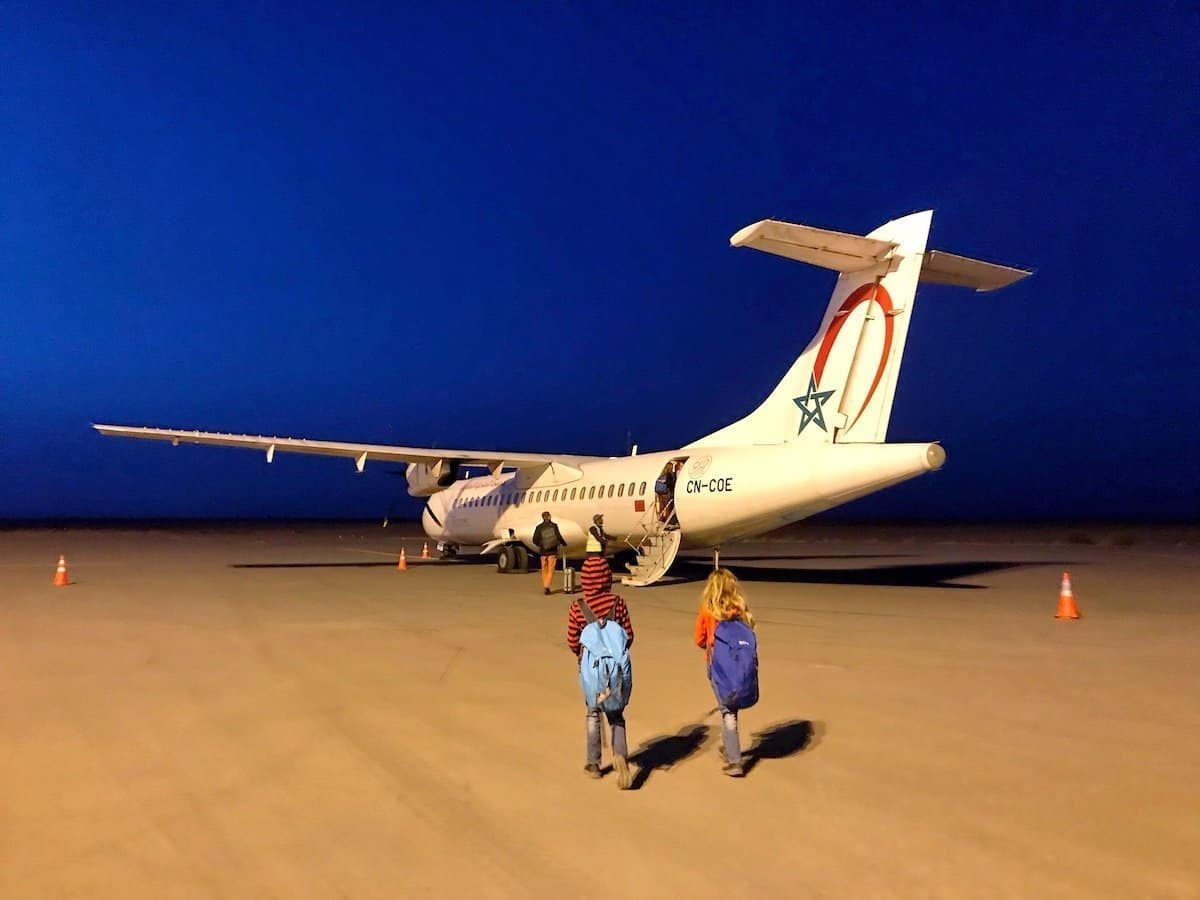
Alternatively, you can fly to the much larger Casablanca airport, and then take a train, changing at Casablanca (Casa Port) for Rabat Ville. This is very easy and cheap – trains leave every 30 minutes, the journey is an hour and a half and the fare is just – 80 dhs ($8) for an adult.
By Rail
The main station in Rabat is Rabat Ville station. You can get here from
- Casablanca – 1 hour
- Meknes – 1 hour
- Fes – 2.5 hour
- Marrakech – 3,5 hours
By Bus
There is an excellent network of buses connecting Rabat with the rest of Morocco. I would recommend using CTM or Supratour buses. You can read about transport in Morocco in our post-Morocco Travel Tips
Day trip out of Rabat
- Casablanca
- Meknes
- Volubilis
- Fes
Read more about Morocco
Disclaimer
We have researched facts stated here as far as practicable, but please check anything critical before committing your time and money. We do not claim any special knowledge or expertise, and we are not consultants for our readers.
Things to do in Rabat – Pin it for later
